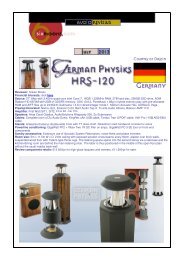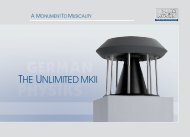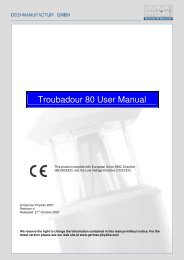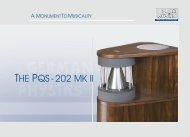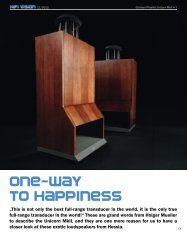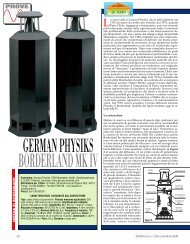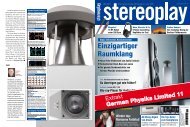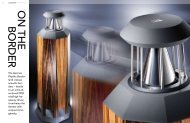Loreley Mk III User Manual - German Physiks
Loreley Mk III User Manual - German Physiks
Loreley Mk III User Manual - German Physiks
Create successful ePaper yourself
Turn your PDF publications into a flip-book with our unique Google optimized e-Paper software.
Input Terminal Connections<br />
NOTE:<br />
The loudspeaker terminals should be tightened as firmly as<br />
possible by hand. Do not use pliers or any other tools as<br />
this may damage the terminals.<br />
The provision of separate inputs the low frequency and high frequency sections of the crossover allows<br />
the <strong>Loreley</strong> to be operated in 3 modes:<br />
Single wire connection<br />
Bi-wire connection<br />
Bi-amp connection<br />
Single Wire Connection<br />
This is the most commonly used method of connecting a loudspeaker and power amplifier. Only one<br />
loudspeaker cable is used for each loudspeaker. The <strong>Loreley</strong> will be shipped configured for this mode<br />
of operation. In this case the red terminals on the DDD and woofer inputs will be connected together<br />
and the black terminals on the DDD and Woofer inputs will be connected together. These connections<br />
must be made using the special links provided. The loudspeaker cable should be connected to the<br />
woofer input terminals.<br />
An amplifier capable of delivering at least 550W rms into 4 ohms per channel should be used for each<br />
speaker.<br />
Bi- Wire Connection<br />
In this method of connection the woofer and DDD inputs are connected to the power amplifier with<br />
separate loudspeaker cables. Ensure that the links fitted between the woofer and DDD input terminals<br />
have been removed.<br />
An amplifier capable of delivering at least 550W rms into 4 ohms per channel should be used for each<br />
speaker.<br />
Bi- Amp Connection<br />
In this method of connection the woofer and DDD inputs are driven by separate power amplifiers.<br />
Ensure that the links fitted between the woofer and DDD input terminals have been removed.<br />
An amplifier capable of delivering at least 350W rms into 4 ohms per channel should be used for the<br />
woofer input and one capable of delivering at least 200W rms into 4 ohms per channel should be used<br />
for the DDD input.<br />
We recommend that you use loudspeaker cables terminated with high quality spade lugs, as these<br />
provide the best electrical connection. The lugs should be either soldered or crimped to the speaker<br />
cable – the latter is preferred. We do not recommend the use of bare wire to connect to the speaker<br />
terminal. This produces a poor connection that will degrade as the bare conductors become tarnished.<br />
5. LOUDSPEAKER BREAK IN<br />
Like all audiophile equipment, <strong>German</strong> <strong>Physiks</strong> loudspeakers require a break in period from new<br />
before they reach their optimum level of performance. The music used for the break in should be<br />
dynamic in order to properly exercise all the components of the loudspeaker.<br />
For the first 10 hours play the loudspeaker at low level only. This is a level where you would easily be<br />
able to carry out a conversation without needing to raise your voice.<br />
After this, the speaker may be played at normal listening levels. The break in process will be complete<br />
after 200 to 300 hours.<br />
11



